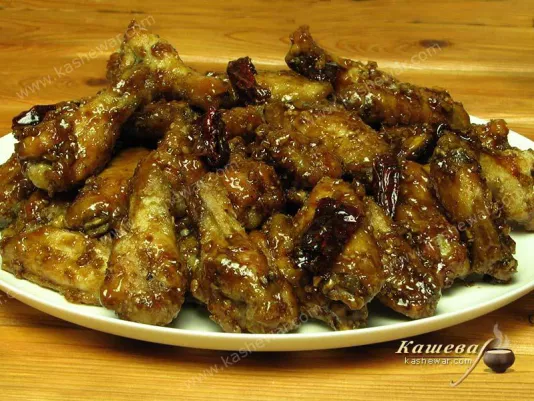Red Fish in Rice Paper
Red fish in rice paper is an incredibly tasty and juicy fish with two types of sauce.

Korean cuisine is a powerful fusion of traditions, aromas, and techniques developed over millennia. It is known for its balance, bold use of spices, and extensive use of fermented ingredients. The core diet consists of rice, vegetables, meat, legumes, and seafood. The concept of “banchan” plays a vital role – a set of small side dishes served with every meal to complement the main course. Korean gastronomy is deeply tied to religious and seasonal rituals, with each dish having a specific purpose – to warm, cleanse, or restore. The most famous Korean dishes – kimchi, bibimbap, samgyetang, tteokbokki, bulgogi – are recognized around the world. Thanks to its focus on health, ability to blend contrasting flavors, and deep respect for tradition, Korean cuisine has earned well-deserved international recognition.
Korean recipes are based on traditional methods of food preparation that preserve nutrition and enhance flavor. One of the most distinctive techniques is fermentation, which gives dishes a vivid and complex aroma. Kimchi – pickled vegetables, usually cabbage or radish with spices, garlic, and ginger – is present in nearly every meal. Bibimbap is a dish of rice, vegetables, egg, and gochujang paste that is thoroughly mixed before eating. Samgyetang is a soup made from young chicken stuffed with rice, garlic, and ginseng, popular during the hot season. Grilled meat (bulgogi) or barbecue is prepared with special marinades. Dishes are accompanied by banchan: soybean sprouts, omelet, seaweed, sweet radish. Soups (guk, tteokguk) and stews (jjigae) are essential in daily meals. Recipes are easy to follow, although some require time for ingredient preparation.
At the heart of Korean gastronomy lies the balance of flavors, colors, and properties of ingredients. Food must be not only tasty but also beneficial: each ingredient in a dish serves a specific function. Rice is the foundation, while all other components act as complements. Banchan are not just appetizers, but part of a philosophy of shared meals, respect for the table, and culinary diversity. Their number ranges from three to dozens and varies with the seasons and available ingredients. Korean cuisine also follows a seasonal approach: more fermented vegetables and hot soups in winter, lighter and cooler dishes in summer. Food is closely tied to medicine: for instance, samgyetang is consumed during summer heat to restore energy. The philosophy of eating shapes not only the diet but a lifestyle aimed at maintaining harmony of body and mind.
Korean cuisine is based on simple but deeply processed ingredients. Staples include rice, garlic, ginger, soy sauce, sesame oil, vinegar, sugar, and fermented pastes – gochujang (chili) and doenjang (soybean). Vegetables play a crucial role: cabbage, radish, spinach, carrot, zucchini. Meats such as beef, pork, and chicken are often marinated and grilled over open flame. Seafood – anchovies, squid, mussels – is widely used in fermented form or as additions to soups. Popular noodle dishes include guksu, ramyeon, and japchae. Kimchi is a must-have – not only as a side dish, but also as a base for soups, stews, and pancakes. Korean cuisine also features beans, mushrooms, and sprouts. Favorite tastes include spicy, salty, sweet-and-sour, and umami. Contrasts are a hallmark: hot and cold, soft and crunchy, sweet and fiery come together in a single meal.
Holidays in Korea are accompanied by unique dishes and rituals. On Seollal (New Year), a soup made with rice cakes – tteokguk – is served, symbolizing entry into the new year. During Chuseok – Korea’s version of Thanksgiving – songpyeon (stuffed rice cakes), kimchi, and vegetable or meat dishes are prepared. Meals are arranged according to strict rules: everything is laid out symmetrically, based on significance. Festive tables reflect respect for ancestors, family, and tradition. Each region has its own versions of holiday dishes, differing in ingredients but sharing common principles. Equally important are the rituals of communal preparation: women from different generations gather to make kimchi for winter (kimjang), which is not only a culinary but also a social event. Korean festive cuisine is a symbol of unity, continuity, and reverence for nature and time.
Today, Korean cuisine is rapidly spreading around the world, maintaining its identity while adapting to new contexts. K-food has become a brand associated with health, bold flavors, and gastronomic trends. Korean restaurants are opening across Europe, America, and Asia, and ingredients are increasingly available in supermarkets. At the same time, interest is growing within Korea in local produce, organic farming, and modernization of traditional recipes. Vegan kimchi, gluten-free noodles, and meat substitutes for barbecue are emerging. Korean chefs experiment with fusion cuisine, combining national flavors with haute cuisine techniques. Still, the core remains unchanged – respect for ingredients, attention to balance, and a focus on dietary harmony. For this reason, Korean cuisine is not just a trend but a source of culinary inspiration worldwide.